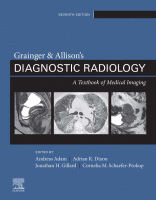Physical Address
304 North Cardinal St.
Dorchester Center, MA 02124

The Adrenal Glands With the increasing use of cross-sectional imaging, adrenal lesions are frequently identified in routine practice and are seen in up to 5% of abdominal computed tomograph (CTs). Recent lung-screening data report 2% of screening low-dose CTs demonstrate…

Introduction There has been a steady advance in the imaging and treatment of genitourinary (GU) system trauma over the past two decades. Multidetector computed tomography (MDCT) has now become the gold standard for the assessment of acute GU trauma. The…

Imaging Techniques Ultrasound (US) Transabdominal and transvaginal ultrasound (TVUS) imaging are the primary initial imaging techniques for examining the female pelvis. Indications include evaluation of a suspected pelvic mass or uterine enlargement, acute pelvic pain, investigation of postmenopausal bleeding and…

Diagnostic imaging tests are essential in the detection and staging of many gynaecological cancers. The imaging findings frequently change treatment strategies and affect our understanding of disease processes. This chapter gives a brief review of common gynaecological malignancies and outlines…

Methods of Examination There has been little evolution in methods of examination since the previous edition. Ultrasound (US) continues to be the method of choice for imaging the scrotal contents but magnetic resonance imaging (MRI) continues to play an increasing…

Introduction With approximately 1.3 million new cases worldwide predicted for 2018, prostate cancer (PCa) is the most common non-cutaneous male cancer. In Western countries, one in every nine men will be diagnosed with PCa at a certain moment in their…

Upper Tract Urothelial Carcinoma Definition Upper tract urothelial carcinoma (UTUC) refers to malignant changes of the uroepithelial cells lining the urinary tract anywhere from the renal calyces to the ureteral orifice. Epidemiology Urothelial carcinoma is relatively common worldwide, and its…

History of Transplantation Renal transplantation was first successfully performed in 1950 in the United States but was limited due to the lack of immunosuppression therapy. Further success was experienced between identical twins where immunosuppression was not required. Cadaveric transplantation became…

Methods of Analysis Plain Abdominal Radiography The plain abdominal radiograph (KUB—kidneys, ureters, bladder) is not used to diagnose a renal mass. Loss of the psoas margin or displacement of retroperitoneal fat may occasionally suggest the presence of one, as may…

Congenital Anomalies Normal Development Detailed embryological development of the kidneys and ureters will not be described in detail. The kidney precursors initially develop in the pelvis and ascend to their normal positions lateral to the proximal lumbar spine by 8…